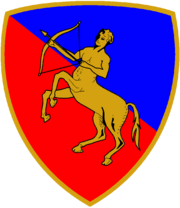Brigata corazzata “Centauro”
The Brigata corazzata “Centauro” ( German tank brigade “Centauro” ) was a major unit of the Italian army . The units of the brigade were stationed in Piedmont and Lombardy until 2002 . The brigade goes back to the 131st Panzer Division "Centauro" , which was one of the three Italian armored divisions during World War II .
history
The brigade was set up on June 1, 1936 as the 1st tank brigade with the 5th (later 7th) Bersaglieri regiment and the 31st tank regiment. On April 20, 1939, the brigade became the 131st Panzer Division "Centauro" (German: Kentaur ) with the 5th Bersaglieri Regiment, the 31st Panzer Regiment and the 131st Panzer Artillery Regiment. The division took part in the occupation of Albania in 1939 and in the disastrous Italian campaign against Greece in 1940; in 1941 it was used in the campaign against Yugoslavia . In 1941 the division received the new 131st Panzer Regiment. From August 1942, the division gradually moved units to North Africa and then fought under General Calvi di Bergolo , especially in the Battle of Tunisia , where it distinguished itself at Gafsa, on the Kasserine Pass, on the Mareth Line and at Akarit.
After the defeat in Tunisia, the division was re-established in Italy by renaming the new 1st Panzer Division "M" (for Mussolini) of the fascist Black Shirts on July 27, 1943 in 136th Panzer Division "Centauro II" and again subordinate it to Calvi di Bergolo . This division was disbanded near Rome in September 1943 after the armistice .
In 1951, a tank brigade called "Centauro" was again set up in Novara , which grew up in 1952 in northwest Italy to become the "Centauro" armored division. It consisted of the 31st Panzer Regiment, the 3rd Bersaglieri Regiment , the 131st Panzer Artillery Regiment , as well as the 15th Cavalry Regiment "Cavalleggeri di Lodi" and various division troops. After experimenting with mixed formations since 1963, the army reform of 1975 created the three mixed brigades of the (de facto mechanized infantry) division : the 31st tank brigade "Curtatone" in Bellinzago Novarese , the mechanized brigade "Legnano" in Bergamo ( the planned restructuring to a tank brigade never took place) and the 3rd Bersaglieri Brigade "Goito" in Milan . In 1986 the division level was completely abolished in Italy and the brigades were placed directly under the corps or military regions. On this occasion, the 31st tank brigade "Curtatone" took over the name of the disbanded division "Centauro".
During the Cold War , the armored division "Centauro" was assigned to III, located in northwestern Italy. Corps , which in the event of an attack by the Warsaw Pact had the task of bringing the enemy to a standstill with the V Corps stationed in the north-east, if possible on the Piavel line.
After the end of the Cold War, the 3rd Bersaglieri Brigade "Goito" was disbanded in 1991, followed by the mechanized infantry brigade "Legnano" in 1997, which in 1993 had been the lead unit in an Italian peacekeeping operation in Somalia . A planned relocation of the tank brigade “Centauro” to Apulia was not carried out, but the two tank regiments ( battalion strength ) 31 and 131 went to southern Italy (where the latter was dissolved in Persano in 2013 , the 31st in Lecce in 2020 ).
In 1996 the brigade consisted of the 2nd and 3rd Bersaglieri regiments in Legnano and Milan , the 4th tank regiment in Bellinzago Novarese , the 52nd "Torino" tank artillery regiment in Vercelli , as well as logistics and training units. The now mechanized brigade temporarily led the 1st cavalry regiment “Nice Cavalleria” and the 21st infantry regiment “Cremona”. All regiments had battalion strength.
In 2002 the brigade was disbanded. The traditional 3rd Bersaglieri regiment and the 4th tank regiment were subordinated to the Ariete tank brigade in Pordenone for a few years , the "Nizza Cavalleria" cavalry regiment went to the Alpini brigade Taurinense in Turin , the artillery regiment to a support association. The smaller brigade staff in Novara took on reserve functions for some time, but normally no longer led their own units.
Until it was disbanded in 2002, the brigade took part in a number of missions abroad, including the missions in Somalia , Albania and the former Yugoslavia .







